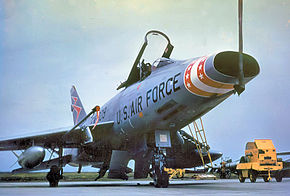This article has multiple issues. Please help improve it or discuss these issues on the talk page. (Learn how and when to remove these messages)
|
The 531st Tactical Fighter Squadron is an inactive United States Air Force unit, last assigned to the 3rd Tactical Fighter Wing at Bien Hoa Air Base, South Vietnam. The squadron was inactivated on 31 July 1970.
| 531st Tactical Fighter Squadron | |
|---|---|
 531st Tactical Fighter Squadron F-100 Super Sabre[note 1] | |
| Active | 1941-1946; 1953-1958; 1958-1970 |
| Country | |
| Branch | |
| Role | Fighter |
| Motto(s) | Strike and Return |
| Engagements | Pacific Ocean Theater[1] Vietnam War |
| Insignia | |
| 531 Tactical Fighter Sq emblem[note 2] |  |
| 531st Fighter Squadron emblem[note 3][2] |  |
| 58th Bombardment Squadron emblem |  |
History
editWorld War II
editActivated in Hawaii in 1941 as the 58th Bombardment Squadron (Light), a Bombardment/Reconnaissance squadron, being equipped with a mixture of B-18 Bolos, second-line P-26s, and A-20 Havocs. Was part of the air defense forces of Hawaii, many aircraft being destroyed during the Pearl Harbor Attack at Hickam Field. Re-equipped with A-24 Dauntless dive bombers in 1942, remained in Hawaii as an air defense squadron until 1943.
Re-designated as a fighter-bomber squadron in mid-1943, deploying to the Central Pacific in 1944 as part of the 21st Fighter Group. Returned to Hawaii and re-equipped with long-range P-38 Lightnings and returned to combat operations in the Central Pacific, operating from Iwo Jima beginning in early 1945 until the end of the war in August. Remained as part of Twentieth Air Force in the Marianas until inactivated in October 1946.
Cold War
editReactivated in 1953 at George AFB, California as an F-86 Sabre Fighter-Bomber Squadron. Spent about a year under Tactical Air Command training, deploying to France in 1954 as part of the NATO buildup of the United States Air Forces in Europe during the early years of the Cold War. Operated from several bases in France during the 1950s, inactivated in 1958 as part of a USAFE reorganization.
Became part of PACAF in 1958, operated F-100 Super Sabres from Misawa AB, Japan as an air defense squadron.
Viet Nam War
editDeployed to South Vietnam, 1965 and carried out combat operations until inactivated in 1970.
Lineage
edit- Constituted as the 58th Bombardment Squadron (Light) on 22 November 1940
- Activated on 1 January 1941
- Redesignated 58th Bombardment Squadron (Dive) on 19 October 1942
- Redesignated 531st Fighter-Bomber Squadron on 14 August 1943
- Redesignated 531st Fighter Squadron on 18 February 1944
- Inactivated on 10 October 1946
- Redesignated 531st Fighter-Bomber Squadron on 15 November 1952
- Activated on 1 January 1953
- Inactivated on 8 February 1958
- Redesignated 531st Tactical Fighter Squadron on 19 May 1958
- Activated on 1 July 1958[3]
- Inactivated on 31 June 1970
Assignments
edit- Hawaiian Air Force (later Seventh Air Force), 1 January 1941
- 21st Fighter Group, 15 June 1944 – 10 October 1946
- 21st Fighter-Bomber Group, 1 January 1953 – 8 February 1958
- 21st Tactical Fighter Wing, 1 Ju1y 1958
- 39th Air Division, 18 June 1960[3]
- 3rd Tactical Fighter Wing, 16 December 1965 – 31 July 1970
Stations
edit
|
|
Aircraft
edit
|
|
References
editNotes
edit- Explanatory notes
- Citations
Bibliography
editThis article incorporates public domain material from the Air Force Historical Research Agency
- Maurer, Maurer, ed. (1983) [1961]. Air Force Combat Units of World War II (PDF) (reprint ed.). Washington, DC: Office of Air Force History. ISBN 0-912799-02-1. LCCN 61060979.
- Maurer, Maurer, ed. (1982) [1969]. Combat Squadrons of the Air Force, World War II (PDF) (reprint ed.). Washington, DC: Office of Air Force History. ISBN 0-405-12194-6. LCCN 70605402. OCLC 72556.
- Ravenstein, Charles A. (1984). Air Force Combat Wings, Lineage & Honors Histories 1947-1977. Washington, DC: Office of Air Force History. ISBN 0-912799-12-9.
- Watkins, Robert A. (2017). Insignia and Aircraft Markings of the U.S. Army Air Force In World War II. Vol. VI, China-Burma-India & The Western Pacific. Atglen,PA: Shiffer Publishing, Ltd. ISBN 978-0-7643-5273-7.